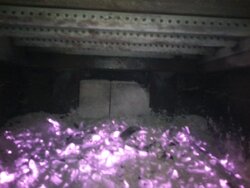1st year with Mansfield.
Yes baffle on top is suppose to be tipped up toward front.
No I'm not crazy about that as if you have any problem with your fire not in a complete burn it makes smoke roll right up it out into the room
Yes the wood HAS to be REALLY Seasoned
No our wood isn't perfect I live in the real world not an ideal world
No you should not burn it with the ash pan open, it can heat way to Hot and if you aren't careful and build up smoke prior to a flash point you can make your own little bomb
Yes it is Hard to keep the coals down, yes they create heat but they build up and fill the stove up
No the ashpan does not last 1 week I have to empty it at least 1x day
No it doesn't heat your house fast it heats it really slow, which is the point of a soapstone (I guess its like cooking w/ a crockpot vs an oven) but it is hard to play catch-up
Yes it goes threw just as much wood as our previous smaller stove
Yes it is worth putting a steamer on it, it doesn't evaporate near as much as our old stove but will go threw more than 1/2 gal a day
Not sure if the blower was worth it, it moves the air out farther but it is a slow heater and so its still a slow heater
No it is not a good idea to run fan at night it keeps the stack from staying within good temperatures
Yes I still have to load it every 4hrs or so, I never turn air intake down temp drops if I do
Its the winter in the NE and the temp hangs around 0 deg.
Yes baffle on top is suppose to be tipped up toward front.
No I'm not crazy about that as if you have any problem with your fire not in a complete burn it makes smoke roll right up it out into the room
Yes the wood HAS to be REALLY Seasoned
No our wood isn't perfect I live in the real world not an ideal world
No you should not burn it with the ash pan open, it can heat way to Hot and if you aren't careful and build up smoke prior to a flash point you can make your own little bomb
Yes it is Hard to keep the coals down, yes they create heat but they build up and fill the stove up
No the ashpan does not last 1 week I have to empty it at least 1x day
No it doesn't heat your house fast it heats it really slow, which is the point of a soapstone (I guess its like cooking w/ a crockpot vs an oven) but it is hard to play catch-up
Yes it goes threw just as much wood as our previous smaller stove
Yes it is worth putting a steamer on it, it doesn't evaporate near as much as our old stove but will go threw more than 1/2 gal a day
Not sure if the blower was worth it, it moves the air out farther but it is a slow heater and so its still a slow heater
No it is not a good idea to run fan at night it keeps the stack from staying within good temperatures
Yes I still have to load it every 4hrs or so, I never turn air intake down temp drops if I do
Its the winter in the NE and the temp hangs around 0 deg.



